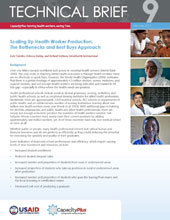
New Publication Spotlight: Scaling Up Health Worker Production: The Bottlenecks and Best Buys Approach
Countries need to rapidly scale up the production of health workers in order to ensure universal access to health care and address the global shortage of over four million doctors, nurses, midwives, and support workers. In many cases, small but targeted investments in the preservice education of health workers can lead to measurable increases in the production of qualified and competent graduates.
A new CapacityPlus technical brief, Scaling Up Health Worker Production: The Bottlenecks and Best Buys Approach, presents an overview of an approach to help identify critical bottlenecks to providing quality preservice education and prioritize affordable actions for increasing the quantity of graduates while maintaining or improving the quality of education.
Nine core areas of health worker education
Authors Kate Tulenko, Rebecca Bailey, and Richard Seifman describe a set of nine areas in which virtually all health professional schools may encounter bottlenecks when considering scaling up production:
 Educators
Educators- Students
- Management
- Infrastructure
- Materials and equipment
- Curriculum
- Clinical practice
- Quality assurance
- Partnerships and exchange.
Learning about constraints in these areas can guide a school in prioritizing its “best buys” in scaling up its education and training programs.
The Bottlenecks and Best Buys approach
The bottlenecks assessment enables a preservice education institution to look at the nine core areas in whole or part. It involves conducting interviews with key informants, surveying educators and students, and observing educational facilities. This evaluation can determine if there are multiple gaps or just a few critical areas needing priority attention.
Best buys are interventions that address key bottlenecks in the most affordable way, and are likely to have the largest impact on scaling up the production of quality graduates with relatively modest additional investment.
New tools
CapacityPlus has developed and pilot tested a set of tools to facilitate the process. The main instruments are a readiness checklist, an assessment guide, data collection tools, and a data collection matrix with suggested indicators and sources of data for each of the nine areas of health worker education. Copies of these tools can be requested from CapacityPlus.
One example of using this approach
A bottlenecks assessment conducted at a midwifery training school in Ghana found that by adding one classroom and five full-time educators the school could increase annual admissions for its three academic programs by 100 students. The estimated one-time investment needed was $27,000 for the classroom and $12,850 for the first year of salaries for the five additional instructors. After the first year, revenue generated through the tuition and fees of the 100 additional students would cover the annual cost of salaries for the five instructors.
Learn more
To learn more, read the technical brief—available as an interactive version and a PDF. And please let us know what you think; we welcome your feedback.
Related items:


